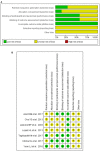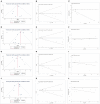Lipid-Lowering Efficacy of the Capsaicin in Patients With Metabolic Syndrome: A Systematic Review and Meta-Analysis of Randomized Controlled Trials
- PMID: 35299764
- PMCID: PMC8923259
- DOI: 10.3389/fnut.2022.812294
Lipid-Lowering Efficacy of the Capsaicin in Patients With Metabolic Syndrome: A Systematic Review and Meta-Analysis of Randomized Controlled Trials
Abstract
Background: Patients with metabolic syndrome (MetS) have increased cardiovascular risk. Capsaicin (CAP) has been shown to reduce lipids, but efficacy for patients with MetS is unknown.
Methods: A systematic review was performed according to PRISMA guidelines, to compare the effects of CAP against a placebo. Differences in the weight mean difference (WMD) with 95% confidence intervals (95% CI) were then pooled using a random effects model.
Results: Nine randomized controlled trials including 461 patients were identified in the overall analysis. CAP significantly decreased total cholesterol (TC) (WMD = -0.48, 95% CI: -0.63 to -0.34, I 2= 0.00%) and low-density lipoprotein cholesterol (LDL-C) (WMD = -0.23, 95% CI: -0.45 to -0.02, I 2 = 68.27%) among patients with MetS. No significant effects of CAP were found on triglycerides (TG) or high-density lipoprotein cholesterol (HDL-C) (WMD = -0.40, 95% CI: -1.50 to 0.71, I 2 = 98.32%; WMD = -0.08, 95% CI: -0.21 to 0.04, I 2 = 86.06%). Subgroup analyses indicated that sex and intervention period were sources of heterogeneity. The results revealed that CAP decreased TG levels in women (WMD = -0.59, 95% CI: -1.07 to -0.10) and intervention period <12 weeks (WMD = -0.65; 95% CI: -1.10 to -0.20). And there was no potential publication bias according to funnel plot, Begg' test and Egger regression test.
Conclusions: CAP supplementation is a promising approach to decreasing TC and LCL-C levels in patients with MetS. However, short-term (<12 weeks) use of CAP in women may also reduce TG levels.
Systematic review registration: Identifier: CRD42021228032.
Keywords: capsaicin; lipid levels; meta-analysis; metabolic syndrome; randomized controlled trials.
Copyright © 2022 Jiang, Qu, Lin, Shi, Chen and Gao.
Conflict of interest statement
The authors declare that the research was conducted in the absence of any commercial or financial relationships that could be construed as a potential conflict of interest.
Figures






Similar articles
-
Lipid-Lowering Efficacy of Kuding Tea in Patients With Metabolic Disorders: A Systematic Review and Meta-Analysis of Randomized Controlled Trials.Front Nutr. 2022 Apr 28;9:802687. doi: 10.3389/fnut.2022.802687. eCollection 2022. Front Nutr. 2022. PMID: 35571915 Free PMC article.
-
Effects of α-linolenic acid intake on blood lipid profiles:a systematic review and meta-analysis of randomized controlled trials.Crit Rev Food Sci Nutr. 2021;61(17):2894-2910. doi: 10.1080/10408398.2020.1790496. Epub 2020 Jul 9. Crit Rev Food Sci Nutr. 2021. PMID: 32643951
-
Effects of dietary eicosapentaenoic acid and docosahexaenoic acid supplementation on metabolic syndrome: A systematic review and meta-analysis of data from 33 randomized controlled trials.Clin Nutr. 2021 Jul;40(7):4538-4550. doi: 10.1016/j.clnu.2021.05.025. Epub 2021 Jun 5. Clin Nutr. 2021. PMID: 34229258
-
The effects of carnitine supplementation on clinical characteristics of patients with non-alcoholic fatty liver disease: A systematic review and meta-analysis of randomized controlled trials.Complement Ther Med. 2020 Jan;48:102273. doi: 10.1016/j.ctim.2019.102273. Epub 2019 Nov 29. Complement Ther Med. 2020. PMID: 31987257
-
The effects of resveratrol on lipid profiles and liver enzymes in patients with metabolic syndrome and related disorders: a systematic review and meta-analysis of randomized controlled trials.Lipids Health Dis. 2020 Feb 17;19(1):25. doi: 10.1186/s12944-020-1198-x. Lipids Health Dis. 2020. PMID: 32066446 Free PMC article.
Cited by
-
Capsaicin: A Potential Treatment to Improve Cerebrovascular Function and Cognition in Obesity and Ageing.Nutrients. 2023 Mar 22;15(6):1537. doi: 10.3390/nu15061537. Nutrients. 2023. PMID: 36986266 Free PMC article. Review.
-
Capsaicin (But Not Other Vanillins) Enhances Estrogen Binding to Its Receptor: Implications for Power Sports and Cancers.Life (Basel). 2025 Jan 30;15(2):208. doi: 10.3390/life15020208. Life (Basel). 2025. PMID: 40003617 Free PMC article.
-
Capsaicin Ameliorates High-Fat Diet-Induced Atherosclerosis in ApoE-/- Mice via Remodeling Gut Microbiota.Nutrients. 2022 Oct 17;14(20):4334. doi: 10.3390/nu14204334. Nutrients. 2022. PMID: 36297020 Free PMC article.
-
Secondary Metabolites from a New Antibiotic-Producing Endophytic Streptomyces Isolate Inhibited Pathogenic and Multidrug-Resistant Mycobacterium tuberculosis Strains.Trop Med Infect Dis. 2025 Apr 23;10(5):117. doi: 10.3390/tropicalmed10050117. Trop Med Infect Dis. 2025. PMID: 40423347 Free PMC article.
References
-
- Alberti KG, Eckel RH, Grundy SM, Zimmet PZ, Cleeman JI, Donato KA, et al. . Harmonizing the metabolic syndrome: a joint interim statement of the International Diabetes Federation Task Force on Epidemiology and Prevention; National Heart, Lung, and Blood Institute; American Heart Association; World Heart Federation; International Atherosclerosis Society; and International Association for the Study of Obesity. Circulation. (2009) 120:1640–5. 10.1161/CIRCULATIONAHA.109.192644 - DOI - PubMed
-
- Grundy SM, Brewer HB Jr, Cleeman JI, Smith SC Jr, Lenfant C. American Heart Association, et al. Definition of metabolic syndrome: report of the National Heart, Lung, and Blood Institute/American Heart Association conference on scientific issues related to definition. Circulation. (2004) 109:433–8. 10.1161/01.CIR.0000111245.75752.C6 - DOI - PubMed
Publication types
LinkOut - more resources
Full Text Sources
Miscellaneous

